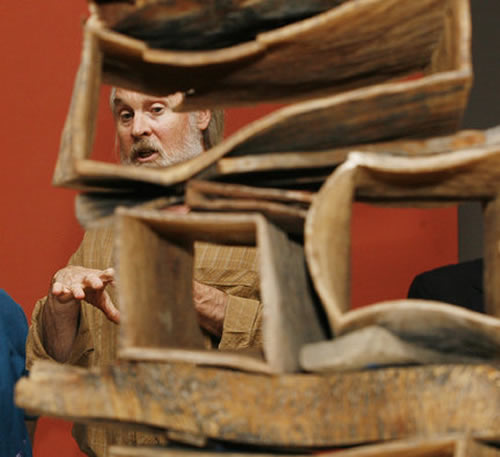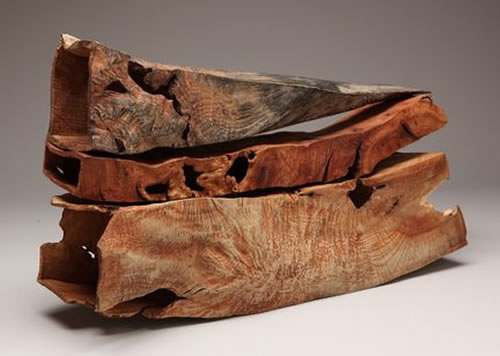
 Sculpture News at SculptSite.com
Sculpture News at SculptSite.com
Michael Peterson Wood Sculpture |
| al.com by Thomas B. Harrison Michael Peterson's sculptures are 'poetry in wood'Michael Peterson's artwork has been described as bold, elegant, poetic and even "cutting edge," although that stretches the limits of tongue-in-cheek wit. Certainly there is a boldness about his approach and his choice of material. Wood, like glass, provides a narrow margin for error; yet Peterson rather fearlessly uses maple, cedar, sea grape locust, elm and madrona burl to create an astonishing array of shapes and forms. His sculptures are elegant, yes, and they embody the poetry of the spirit. Michael Monroe, director of curatorial affairs for the Bellevue Arts Museum, writes: "The unity and simplicity of the sculptural forms he creates allows them to serve as compelling visual metaphors for the essential order and clarity desirable in a balanced life." "Michael Peterson: Evolution/Revolution," organized by Bellevue Arts Museum and co-curated by Monroe and Stefano Catalani, is on view through Oct. 3 at the Mobile Museum of Art in Langan Park. This is the first comprehensive look at Peterson's wood sculptures features more than 30 sculptures and traces the artist's trajectory from his early works on the tried-and-true lathe - the artist's "evolution," writes Monroe - to his recent organic abstract forms created with a chainsaw. Born in Wichita Falls, Texas, Peterson resides on Lopez Island, one of the San Juan Islands in Washington, where he is profoundly influenced by the capricious environment of the Pacific Northwest. As Monroe notes in his foreword, the artist must contend with a host of geographical and atmospheric issues including "emerald green vegetation, the majestic mountains, the bright or blustery, Payne's grey skies and water, craggy islands and trees shrouded in fog, a blending of misty, moody atmospheres - all heightened by the temperamental weather." Peterson works outdoors without protection in inclement weather. He begins with damp chunks of wood that he carves and hollows with a chainsaw. As the wood dries, it shrinks and warps in unpredictable ways, creating exaggerated grain patterns and textures. He smoothes the edges and sometimes bleaches the wood before layering the pieces with multiple coats of pigment. He then wipes away these pigments to create the illusion of depth. Some of the sculptures contain hollowed-out units that, when stacked vertically, are reminiscent of waves that toss driftwood onto the beach. In an interview with Monroe for the catalog, Peterson is asked about his decision to move away from creating thin-walled works favored by many of his fellow wood sculptors. "While I admired and made several thin-walled pieces, my motivation was not technical achievement," he says. "My energy was coming from a more primitive source and evolving to translate landscape imagery to the vessel form. I needed more substantial wall thickness to allow for the additional relief, and undulating contours to achieve a more asymmetrical look." In addition to his work with the chainsaw, Peterson also works with handmade carving tools unique to the region. He sandblasts some of his pieces as well. "Sandblasting was inspired by my appreciation for the earth's natural sculpting forces," he says in the catalog interview. "geological textures and natural patinas, such as weathered bone. Now I use it to lay a foundation of texture and relief for further surface treatments. "This might be followed by a layering process of bleaching for a lightening effect, then pigmentation for color and darkening. This process has a lot of variables and few absolutes." Peterson says his work involves almost all the human senses. "The work is really read with the hands and the eyes," he says, "and if it goes beyond the two senses . . . it might bring in other more internal feelings. I place a lot of importance on the tactile quality as well as the visual success of the surface." |
 Sculpture in Wood is a hard medium to judge or be critical of, it is what it is... Working in wood is a way of life for many wood carvers, they seem to be very passionate about their medium. To me a majority of wood sculpture is representational or near representational in a woodsy sort of way, and that is just fine. In fact I'm in Northern Michigan as I write this and am expereincing wood sculpture and wood shapes in many of the public places, as well as some private homes or lodges that I have visited. It is a good feeling. Michael Peterson is in a world all his own when it comes to working with wood, it's shape and message. It is the opposite of most wood sculpture in it's shape and form, I find his work invigorating to say the least. If you are ever near a venue to view his work, by all means take the time. The Bellevue Arts Museum is featuring his work now, so go! Thanks to Thomas B. Harrison for a wonderful read on Michael Peterson. |
 |
 |
More Sculpture News ....
Submit your SCULPTURE NEWS.
It's easy, just send us an e-mail
(click on Submit News in the left menu) with your pertinent information along with images, we'll take care of the rest. Sculpture makes our world a much better place in so many ways!
SculptSite.com, along with Sculptors and their creative genius all helping to bring the beauty and message of Sculpture to a hurried world.

